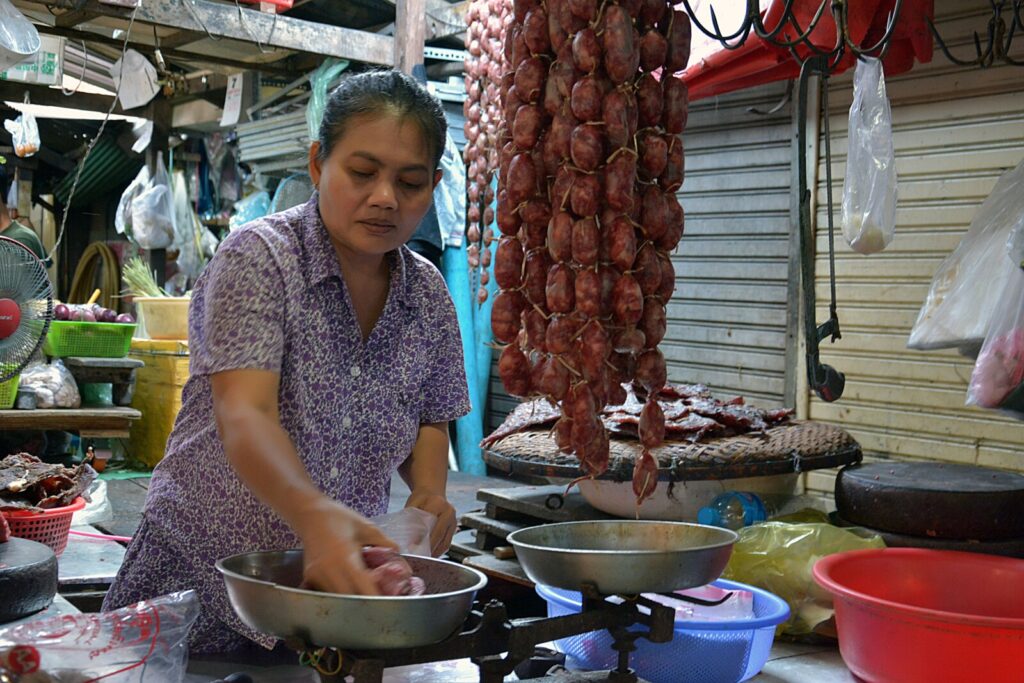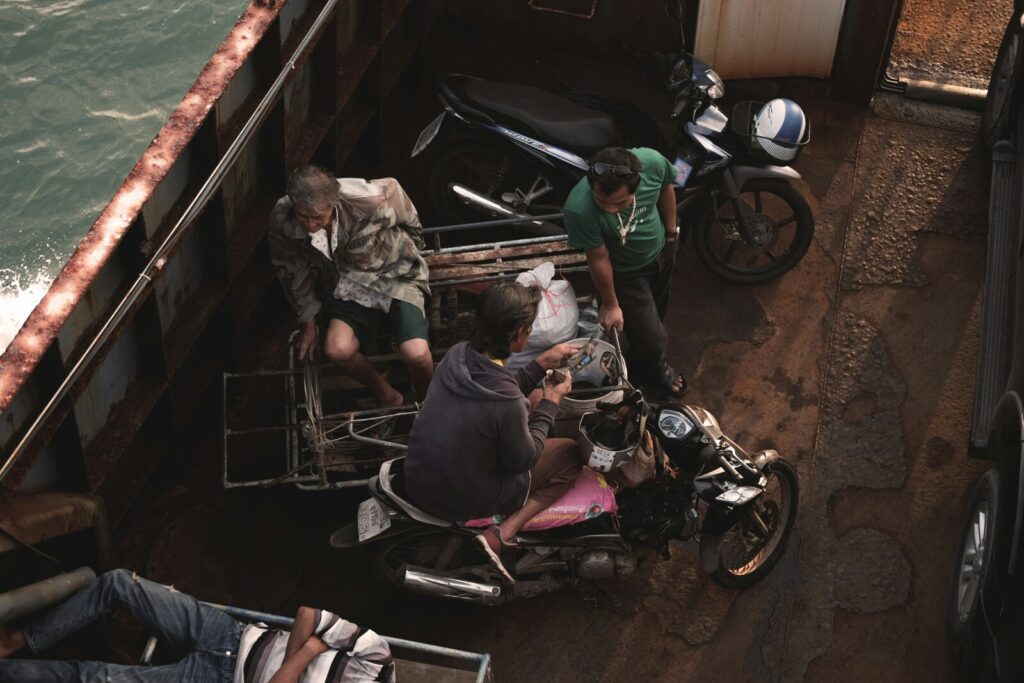Cambodia, a relatively small country located in Southeast Asia, has a lot to offer if you choose it as a destination for your volunteer experience.
Its rich history dates back to the civilization of the Khmer Empire, famous for building an iconic monument, Angkor Wat, one of the largest and most well-known religious monuments in the world.
Cambodia is known for its flat geography, with much of the country made up of low-lying areas and floodplains, making it ideal for rice cultivation. It shares borders with Thailand to the west, Laos to the north, and Vietnam to the east and southeast, all of which have directly influenced the country’s gastronomy, and that’s precisely what we are here to talk about today.
Here are some of the most well-known and popular dishes you can try in this country if you live there during your unforgettable trip.

- AMOK
This is one of the most famous dishes in Cambodia. It is a mild and creamy curry, typically prepared with fish, mixed with coconut milk, banana leaves, and kroeung paste (a blend of Khmer spices). It is often steamed in banana leaves and has a mild but very aromatic flavor.
Traditionally, freshwater fish is used, as Cambodia is traversed by many rivers. However, in some versions, chicken or even tofu can be used. Amok curry is made with a special paste called ‘kroeung,’ which is a blend of Cambodian herbs and spices such as turmeric, lemongrass, galangal (similar to ginger), and kaffir lime leaves. These ingredients are mixed with coconut milk to form a thick and rich sauce.
Once the fish is mixed with the sauce, everything is wrapped in banana leaves and steamed. This cooking method gives the dish a soft texture, almost similar to a pudding, which is part of what makes it so distinctive. It is served with white rice, which helps balance the flavors of the dish and allows for a better enjoyment of the creamy curry sauce.
It is a blend of sweet, creamy, aromatic flavors with a mild spiciness that is essential in Asian cuisine.
While traditional Amok is made with fish, there are also modern versions with chicken, pork, or even seafood. In some places, the dish is served directly in a decorated banana leaf bowl, giving it a very attractive presentation. Not only is it delicious, but it is also a unique visual and sensory experience, representative of the balance of flavors and textures that characterize Cambodian gastronomy.
- LOK LAK
Another very popular stir-fry dish, typically prepared with marinated beef. The meat is served on a bed of lettuce, tomato, cucumber, and onion, accompanied by a sauce made from black pepper, lime juice, and soy sauce. It is usually served with rice and sometimes topped with a fried egg.
The base of Lok Lak is beef (although chicken or pork is sometimes used), cut into chunks or slices and marinated in soy sauce, oyster sauce, garlic, sugar, and sometimes a touch of black pepper. After marinating the meat, it is stir-fried over high heat until well cooked but juicy inside. This process gives the meat a deep flavor and a slightly caramelized finish due to the sugar in the marinade.
Traditional Lok Lak is served over a bed of fresh vegetables like lettuce, tomato slices, cucumber, and onion. The vegetables provide freshness and a crunchy texture that contrasts with the tender meat.
One of the most distinctive elements of Lok Lak is the Kampot pepper and lime sauce. This sauce is made by mixing fresh lime juice with ground Kampot black pepper (a region in Cambodia famous for its pepper), salt, and sometimes a bit of soy sauce. The sauce is tangy and spicy, used for dipping the pieces of meat. As mentioned, it is almost always served with white rice, which absorbs the juices from the meat and the sauce, and sometimes a fried egg is added on top for extra richness.
It is a blend of savory, umami, acidic, and spicy flavors.
Although the most popular version is with beef, there are also variations. In some restaurants, it is served with French fries as a side dish, reflecting the influence of French cuisine in Cambodia.
It is a very accessible dish and can be found in all types of establishments, from simple restaurants to more elegant places. It is a favorite option for both locals and tourists, as it combines fresh ingredients with intense but balanced flavors.
- BAI SACH CHROUK
This is a simple yet delicious dish typically eaten for breakfast. It consists of grilled pork marinated in garlic, soy sauce, and palm sugar, served over white rice with cucumber and pickled radishes, and sometimes accompanied by a fried egg and a light soup.
The main ingredient is pork (usually thin slices) marinated in a mixture of garlic, soy sauce, palm sugar, and sometimes coconut milk or fish sauce. The pork is marinated well in advance so that the flavors penetrate the meat. These ingredients give the pork a slightly sweet and salty flavor that is enhanced during grilling. It is often cooked slowly over charcoal, giving it a smoky aroma and caramelized flavor. The pork is served over a generous portion of white rice, which is the perfect accompaniment to absorb the juices from the meat and balance the stronger flavors.
In many places, a fried or poached egg is also included as part of the dish, adding extra richness and protein. Sometimes, Bai Sach Chrouk is accompanied by a light chicken or pork soup, served on the side to enjoy with the rice.
Depending on the region or where you eat it, there may be slight variations in the marinade for the pork or the accompaniments. Some versions add a touch of coconut milk to the marinade for a creamier texture to the meat, while others include a variety of fresh herbs.
This dish is commonly found at street stalls and small cafés in Cambodian cities, particularly in the mornings. It is a very popular option because it is simple to prepare, satisfying, and economical, making it a perfect breakfast for Cambodians looking for something quick before starting their day.
- NOM BANH CHOK
This is a traditional Cambodian rice noodle dish, very popular for breakfast, and is considered a symbol of local cuisine. Often referred to as “Khmer noodles,” it is served with a mild curry mixture and a variety of fresh herbs and vegetables. This dish is refreshing, light, and full of flavor, and is an integral part of daily life in Cambodia.
The main ingredient of the dish is long, thin rice noodles. They are soft and light, traditionally handmade in rural areas of Cambodia. These noodles are very delicate and absorb the flavors of the soup or curry with which they are served very well.
It is typically served with a mild green curry based on fish, although there are versions with red or yellow curry. This curry is prepared with fresh ingredients like turmeric, lemongrass, galangal (similar to ginger), kaffir lime, and often includes shredded freshwater fish.
One of the highlights of this dish is the abundance of fresh herbs and crunchy vegetables served alongside the noodles. It includes bean sprouts, cucumber, banana flower, mint leaves, basil, and sometimes lime or lemon slices. These ingredients provide freshness and texture to the dish.
In some versions, the curry may be more liquid, turning into a light soup that covers the noodles and herbs. In others, the curry may be thicker but always retains a mild and aromatic flavor. In the northern part of the country, for example, you may find a version with red curry, which has a more intense and spicy flavor. In other areas, it may be prepared with a tamarind-based sauce, which adds a more pronounced acidic touch.
Another simpler and less common variant is served with clear fish broth instead of curry, making it a light and refreshing noodle soup, perfect for hotter days.
It is a dish traditionally consumed at breakfast, although in some parts of the country, it can be enjoyed throughout the day. It is commonly sold at street markets and by street vendors, who carry the noodles and curry in large pots or baskets. This dish also holds significant cultural value, as it is often served during festivals and religious ceremonies in Cambodia, as part of traditional offerings to Buddhist monks.

- KUY TEAV
It is a very popular noodle soup consumed both at breakfast and lunch, and can be found in almost every corner, from street stalls to restaurants. This dish has influences from Chinese and Vietnamese cuisine, and its simplicity and flavor have made it a favorite for any occasion.
The base element is thin rice noodles, which are soft and absorb the flavor of the broth very well. These noodles are briefly cooked in hot water and then served in a bowl with broth.
The broth is the soul of this dish and is usually prepared with pork or beef bones, which are simmered for several hours to extract all the flavors. It is often flavored with garlic, onion, ginger, and a touch of sugar, achieving a perfect balance between salty and sweet. It can also include other proteins such as meatballs (similar to meatballs), strips of beef, or shrimp.
One of the most distinctive aspects is the variety of fresh herbs and vegetables served with the soup. The most common are: bean sprouts, mint or basil leaves, cilantro, green onion, and lime or lemon.
On the tables of stalls and restaurants, you will find a variety of condiments to customize the dish, including: sugar, fish sauce, fresh or pickled chilies, and black pepper.
There are several versions depending on the region or the personal preferences of the cook. Some examples include a mix of pork, liver, meatballs, and shrimp. It is also often served with a small amount of fried garlic and pork fat to enhance the flavor.
Instead of pork, some opt to use cooked beef strips or minced beef, and instead of being served as soup, the noodles and meat are served dry, with the broth on the side to add to taste, along with a special soy and garlic sauce.
- PRAHOK
It is a central and distinctive element of Cambodian cuisine, known for its intense and particular flavor. It is a fermented fish paste used both as a condiment and as a main ingredient in various dishes. Its strong, salty, and sometimes spicy flavor is appreciated by many, although it may be an acquired taste for those who are not used to it.
It is made from fish (generally freshwater fish) that is left to ferment with salt for several days or even months. The fermentation process transforms the fish into a thick, aromatic paste with a very concentrated flavor. It has an extremely strong and salty taste, with a hint of acidity due to the fermentation. The smell of Prahok is also very penetrating, which can be shocking for those who are not accustomed to it, but it is considered a delicacy by Cambodians. While it can be consumed alone, it is often used as a condiment to enhance the flavor of other dishes or cooked in sauces, stews, or side dishes. It can be served raw or cooked, depending on the recipe.
One of the most popular preparations is a rich and creamy sauce that combines cooked Prahok with minced pork, coconut milk, chilies, garlic, and fresh herbs such as lemongrass and turmeric. It is served as a dip along with fresh vegetables or rice. This is a way to soften the strong flavor of Prahok and make it more accessible.
The standout flavors are salty and strong, fermented, smoked, or toasted.
It is considered a staple food in many Cambodian families, and is often referred to as “Cambodia’s cheese,” which some compare to European blue cheeses or Korean kimchi.
- SOMOLOR MACHU
It is an emblematic dish of Cambodian cuisine, known for its sweet and sour refreshing flavor. “Samlor” means “soup” in Khmer, and “Machu” translates to “acid,” reflecting the essence of this dish. It is a versatile soup that can be prepared with different types of meat, fish, or even shrimp, and always includes a mix of fresh vegetables, aromatic herbs, and a touch of acidity that gives it its characteristic flavor.
The base is a light broth prepared with tamarind or pineapple to give it a natural acidic flavor. Sometimes lime or lemon juice is also used. The balance between the sweetness of the fruits and the acidity defines this dish. The broth is enriched with ingredients such as garlic, lemongrass, and galangal, which provide a fresh and deep aroma.
Different proteins can be used, such as pork, freshwater fish, shrimp, chicken, and even tofu.
The soup always includes a generous amount of fresh vegetables. The most common are: tomatoes, fresh pineapple, bamboo shoots, spinach, and bean sprouts.
It is seasoned with fish sauce, palm sugar, and chilies.
There are versions that incorporate a mix of aromatic herbs (called “kreung” in Khmer), including galangal, lemongrass, turmeric, and kaffir lime leaves, giving it a more complex and herbal flavor profile. There is also a variant prepared with pineapple and pork, with a less acidic but sweeter taste due to fresh pineapple, or a variant with Vietnamese influences, where fish is used and the sour flavor primarily comes from tamarind, often including more leafy greens.
The balance between the sweetness of pineapple or palm sugar and the acidity of tamarind or lemon defines this dish. The flavors are refreshing and light, making it a perfect soup for warm climates.
It is a very popular dish in everyday Cambodian cuisine and is usually served as part of a larger meal, accompanied by rice. It is considered a “comfort soup,” ideal for any time of day, whether as breakfast or part of lunch or dinner.

There are other popular dishes such as Ansom Chek, Cha K’dam, or Lap Khmer… You can enjoy all these dishes in restaurants or street stalls if you choose Cambodia to live your volunteering experience.
Traveling is about opening the mind and immersing ourselves in cultures that allow us to taste things completely different from what we are used to.




